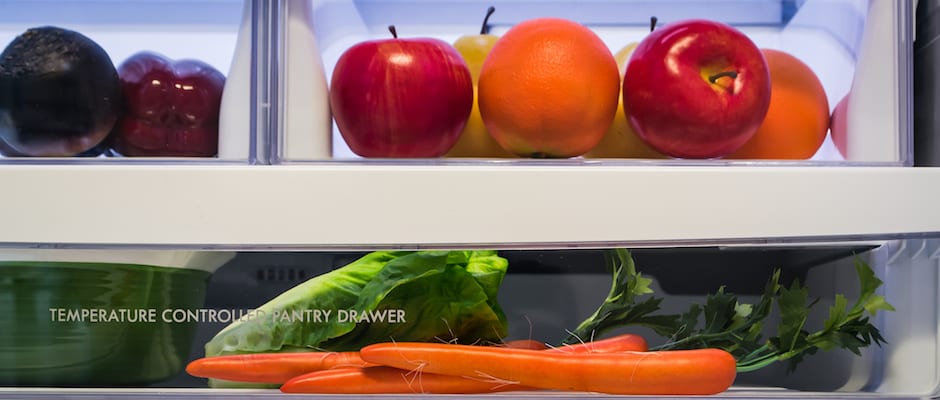Pros
Cons
Design & Usability
A thinner French door.
The 71032 comes in the standard French door setup, but compared to larger models everything seems a little squished together. Thin shelves keep it from feeling too cramped. Unlike some of the other Kenmore French doors we've tested, those spill-protected shelves don't slide back, but they do slide out a few inches to improve access. We appreciate the door-mounted icemaker, since it frees up space on the top shelf. Despite the thinner physique, the 71032 still has tons of space, and the doors can easily accommodate gallons of milk and bottles of champagne.

We weren't particularly pleased with the crisper drawer movement. Not only did it not slide smoothly, but it didn't close very well, either. That presented a problem for the humidity test, as we found out.
The freezer features two drawers: a large trough-like one with a movable divider, and a shallower drawer with a removable tub. Unfortunately, access isn't ideal in this setup. The top, shallower drawer doesn't roll out very far, necessitating more reach than we're comfortable with. In the bottom trough, items can easily get buried at the bottom.
Water, ice, and an energy saving function are controlled via the front control panel. It looks presentable, even though the buttons themselves can be less-than-responsive.
{{ gallery "front", "design", "front"}}
Performance & Features
Good news and bad news.
Let's start with the good: The freezer performed admirably, freezing our test blocks ridiculously quickly, and holding them very consistently at the target temperature—the best way to prevent freezer burn. And when we unplugged it, it stayed freezing for one and half days. That's a sign of good insulation.

The fridge, however, was a different story. In our temperature tests, the 71032 ran warmer than its target temperature and fluctuated significantly. Oddly, the fridge was warmest at the middle, instead of down at the bottom where fresh produce prefers higher temps. Speaking of those crisper drawers, they completely failed to lock in moisture, hemorrhaging water from our hypothetical veggies. If the freezer is a masterpiece, the fridge is incomplete.
For in-depth performance information, please visit the Science Page.
Our Take
Everything but the fridge
The Kenmore 71032 might be a tempting choice, especially if the hole in your kitchen is 33 inches wide. Good looks and a nice fit and finish complete the package. But a lackluster fridge compartment keeps us from giving the 71032 our recommendation. If you do choose it, keep a portable thermometer on hand to ensure temperatures don't rise above 41ºF, and make sure you use your produce while it's still fresh.
The Cold Hard Facts
We think the 71032's issues are issues, but you might have different standards than we do. If that's the case, you've come to the right place. We share our data so you can draw your own conclusions.
Temperature Performance
There's not much to say about the spectacular freezer. It averaged -0.36°F—perfect—and kept fluctuation to a minimum. A+.

The fridge's average of 39.06°F was two degrees above what the 71032's thermostat indicated. We had two sensors cracking 41°F at one point, putting this fridge into potentially dangerous territory had it stayed that warm. It didn't, though, and quickly fluctuated down to 37°F. That's bad news for consistency. The top, middle, and bottom of the fridge averaged 39.22°F, 38.22°F, and 39.72°F respectively, an odd result, since we usually see the warm area at the bottom, and the cold at the top, a setup that benefits the preferred warmer climate of produce.
Moisture Retention
Our produce substitute lost 0.28 grams of water very hour, which isn't great if you don't buy produce every few days. We have a hunch that the drawer not closing very well has something to do with this evaporation problem. Did you know evaporation can happen even when it's cold?

Freezing & Thawing
The freezer was decisively demonstrated its excellence in these two tests. When we put our 500g test blocks into the fridge, they froze almost immediately—for a freezer—taking just an hour and ten minutes to dip below zero.
When we finished testing the freezer, we unplugged it to simulate a power outage. After 36 hours, the freezer still kept its cool under 32°F. It's well insulated.
Storage Space & Energy Efficiency
We measured 11.2 cubic feet of usable space in the fridge and 4.7 in the freezer, which is quite a bit considering the 71032's thin profile. You might think that number is low considering the 25.0 cubic foot figure listed by Kenmore, but they're measuring total volume, not usable space. When we compared the usable space and the power drawer over our testing period, the 71032 turned out to be very efficient. So efficient, in fact, that it'll only cost you $2.96 to run per month, if your electricity is close to the national average of $0.091 per kilowatt hour.
Meet the tester
Ethan writes reviews and articles about science for Reviewed.com, and edits the Science Blog. He's originally from Vermont and thinks the bicycle and guitar are examples of perfected technology. Prior to Reviewed.com, he studied furiously at Middlebury College.
Checking our work.
Our team is here to help you buy the best stuff and love what you own. Our writers, editors, and experts obsess over the products we cover to make sure you're confident and satisfied. Have a different opinion about something we recommend? Email us and we'll compare notes.
Shoot us an email

